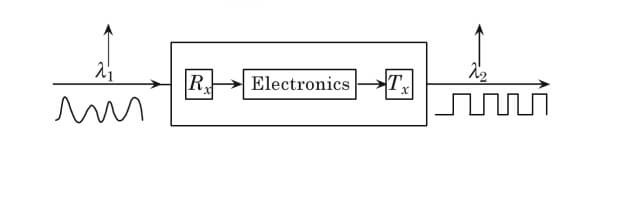/ From: / Review:1351
Fiber optic transponder, also known as wavelength-converting transponder, WDM transponder or fiber to fiber media converter according to its specific applications, plays an important role in WDM (Wavelength Division Multiplexing) system, sepecially in DWDM (Dense Wavelength Division Multiplexing) syetem. Its name "transponder" is a mix of transmitter and responder, which gives us an idea of its purpose. They are protocol and rate-transparent fiber media converters that support SFP, SFP+, XFP and QSFP transceivers with data rates up to 11.32 Gpbs. Fiber optic Transponders extend network distance by converting wavelengths (1310 to 1550), amplifying optical power and can support the “Three Rs” to Retime, Regenerate and Reshape the optical signal. In general, there is an O-E-O (optical-electrical-optical) function with this device. Fiber optic transponders and optical multiplexers are usually present in the terminal multiplexer.
How Does Fiber Optic Transponder Work?
The most obvious feature of a transponder is that it automatically receives, amplifies, and then retransmits a signal on a different wavelength without altering the data/signal content. Wavelength conversion in commercial networks today is only carried out by optical to electronic to optical (O-E-O) transponders. O-E-O Transponder works as a regenerator which converts an optical input signal into electrical form, generates a logical copy of an input signal with a new amplitude and shape of its electrical pulses and uses this signal to drive a transmitter to generate an optical signal at the new wavelength.

Why We Need Fiber Optic Transponder In WDM System?
We need wavelength-concerting transponder for several reasons. First, they connect incompatible equipment. Such an example is the conversion of 1300nm carrying wavelength of optic networks. Another need for converters arises because we have different fiber optic networks with different providers and different standards, therefore, we need fiber optic transponder to traverse from one fiber optic network to another. Fiber optic transponder helps us to reduce the number of wavelengths required.
Development of Fiber Optic Transponder
Signal regeneration was not initially implemented in fiber optic transponders. At first, these transponders were only used to convert the wavelengths of incoming external signals into wavelengths that worked with the WDM systems. This conversion also serves to stabilize the frequencies and amplify the power of these signals into something compatible with the EDFA in the DWDM system. The sophistication of the signal regeneration components in transponders grew as they progressed from 1R to 3R.
1Ris shorthand for reamplification. It was used in the earliest fiber optic transponders. As the name implies, 1R does not employ any methods to "clean up" the signal. Rather, it simply takes the incoming external optical signal and converts it to analog. This process happened regardless of signal integrity. As a result, if the incoming optical signal was "junk", the analog version of it would be "junk" as well. Another consequence of 1R was that, because of the signal degradation inherent to long-range communications that would occur, the practical distance of DWDM systems was limited.
2R is shorthand for reshaping and reamplification. Before the incoming external signal is reamplified, it first goes through a process to clean it up. The quality of the signals was monitored at this point.
3R is shorthand for reamplify, retime, and reshape. This system is more advanced than both 1R and 2R systems. Signal quality can be monitored more closely and accurately, thanks to the inclusion of quality bits embedded in the signal. The quality bits inform the system of the level of health and degradation of the signal. 3R systems are capable of the monitoring of bidirectional communication.
Muxponder has different names depending on vendor. It essentially performs some relatively simple time division multiplexing of lower rate signals into a higher rate carrier within the system (a common example is the ability to accept 4 OC-48s and then output a single OC-192 in the 1550 nm band). More latest muxponder designs have absorbed more and more TDM functionality, in some cases obviating the need for traditional SONET/SDH transport equipment.
Transponder vs Transceiver
A transponder and transceiver are both functionally similar devices that convert a full-duplex electrical signal in a full-duplex optical signal. The difference between the two is that fiber transceivers interface electrically with the host system using a serial interface, whereas transponders use a parallel interface. So transponders are easier to handle lower-rate parallel signals, but are bulkier and consume more power than transceivers. In addition, transceivers are limited to providing an electrical-optical function only (not differentiating between serial or parallel electrical interfaces), whereas transponders convert an optical signal at one wavelength to an optical signal at another wavelength. As such, transponders can be considered as two transceivers placed back-to-back.
Applications of Fiber Optic Transponder
Fiber Optic Transponder can be deployed in a variety of networks and applications:
Convert Multimode to Single-Mode Fiber ("Transponder" for this application is also called Fiber-to-Fiber Media Converters by some users)


Convert Wavelengths with Transponders ("Transponder" for this application is also called WDM Transponders, or Wavelength-converting Transponder by some users)

Extend 10G OTN Network Distances

Extend SONET Ring Distances

Gelink Wavelength-converting Transponders Solutions – OEO WDM Transponder
Gelink has a wide range option for OEO WDM Transponder. You can find the device with transmission speed as 2.5G, 4.25G, 8G, 10G and 40G. In addition, module ports, such as SFP to SFP, SFP+ to SFP+, SFP+ to XFP, XFP to XFP and QSFP to QSFP OEO transponders with linecard or standalone packing type are offered in Fiberstore. Moreover, premium 1U or 2U unified platform chassis for the wavelength-converting transponders are also available. As an important part of CWDM & DWDM Networks, Gelink's wavelength-converting transponders offer a perfect solution for you.
Gelink 1U OEO WDM Transponder

Gelink 2U OEO WDM Transponder
